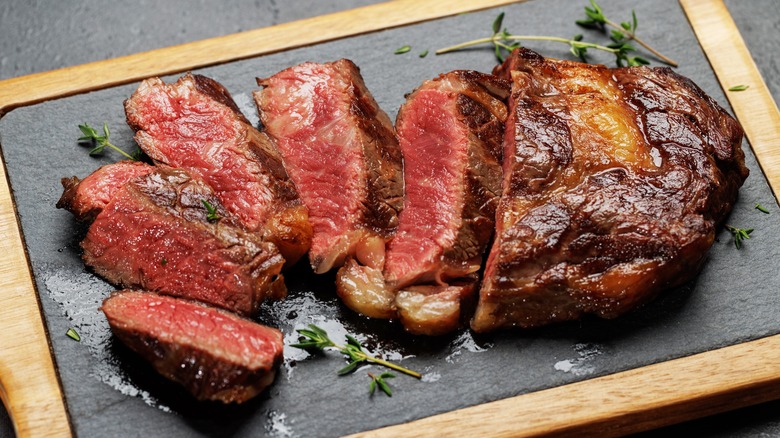Men Over 50 Should Avoid Eating This Steak Cut Every Day (And Eat This Instead)
Eating a thick, juicy steak can feel like a treat on a special occasion, especially accompanied by a side of potatoes and a glass of cabernet. With more people divided between keto and plant-based diets, 12% of the U.S. population eats 50% of the beef, according to a 2023 study in Nutrients. It might not sound surprising that men eat more beef than women.
Yet men over 50 need to pay more attention to their diets to prevent age-related conditions such as type 2 diabetes, cancer, and heart disease. That often means cutting back on foods high in saturated fat such as red meat. The Bearded Butchers says ribeye steak is the most popular steak, but because the meat comes from the rib area, it has fat marbled through the meat.
A 100-gram serving (a little more than 3 ounces) of broiled ribeye steak has 17 grams of fat and 6.5 grams of saturated fat. Prime rib is worse with 27 grams of fat and 11 grams of saturated fat in a 100-gram serving. Compare that to grilled top round steak with 3.8 grams of fat and 1.6 grams of saturated fat per 100 grams. Saturated fat and red meat are often associated with many health risks as you age.
Health risks of saturated fat in ribeye steak
Take a look at your typical serving of steak. If it's larger than a deck of cards, you're getting more than a 3-ounce serving. Your restaurant portion of a steak could be much larger than that, such as the 13-ounce ribeye steak at Outback. That could give you about 24 grams of saturated fat in your entree, and that's not including if you add some butter to your potatoes.
Saturated fat has been associated with higher levels of LDL (bad) cholesterol in your blood, even though not all saturated fats lead to heart disease. High cholesterol, particularly LDL levels over 100, can lead to heart disease or stroke. The American Heart Association suggests keeping your total saturated fat to 5% to 6% of your total calories for the day. If you're not active, men over 50 need between 2,000 and 2,200 calories a day. That comes to 132 calories or less than 15 grams of saturated fat per day if you're aiming for 2,200 calories.
Red meat's other health risks
Red meat provides you with key amino acids, vitamins, and minerals to your diet, but eating red meat every day is also associated with some other health risks, according to a 2016 review in the Journal of Internal Medicine. For every 100 grams of red meat you eat per day, you'll raise your risk for diabetes. Although red meat doesn't affect your blood sugar, researchers are still puzzled about which components could affect your risk of type 2 diabetes.
Eating red meat is also linked to an increased risk of cancer, particularly cancer in the digestive system. Researchers suspect that the release of free iron and heme might increase inflammation, damage cells, and cause genetic mutations that can lead to cancer.
Regardless of the saturated fat in your steak, eating it every day increases your risk of early death, according to a 2018 study in Clinical Nutrition. In people over 45, eating an additional serving of red or processed meat had a 47% higher risk of death. You'll want to replace some of your red meat with fruits, vegetables, and healthy fats. Choosing foods high in saturated fats over healthier fats and carbs will also lead to a higher risk of early death.


